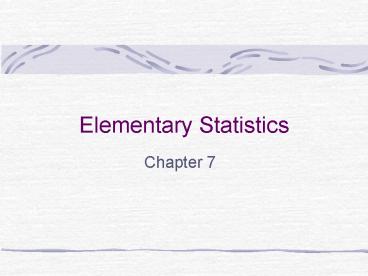Elementary Statistics - PowerPoint PPT Presentation
1 / 31
Title:
Elementary Statistics
Description:
Elementary Statistics Chapter 7 Sample Space A sample space is the set of all possible individual outcomes of a random process. The sample space is typically denoted ... – PowerPoint PPT presentation
Number of Views:262
Avg rating:3.0/5.0
Title: Elementary Statistics
1
Elementary Statistics
- Chapter 7
2
Sample Space
- A sample space is the set of all possible
individual outcomes of a random process. The
sample space is typically denoted by S and may be
represented as a list, a tree diagram, an
interval of values, a grid of possible values,
and so on.
3
Lets Do It!
- Pg. 338, 7.5
4
Event
- An event is any subset of the sample space S. An
event A is said to occur if any one of the
outcomes in A occurs when the random process is
performed once.
5
Lets Do It!
- Pg. 390, 7.7
6
Set Notation
- Union A or B
- Intersection A and B
- Complement not A
7
Disjoint
- Two events A and B are disjoint or mutually
exclusive if they have no outcomes in common.
Thus, if one of the events occurs, the other
cannot occur.
8
Basic Probability Rules
- Any probability is always a numerical value
between 0 and 1. The probability is 0 if the
event cannot occur. The probability is 1 if the
event is a sure thing. 0P(A)1. - If we add up the probabilities of each of the
individual outcomes in the sample space, the
total probability must be equal to one P(S)1. - 3. The probability that an event occurs is 1
minus the probability that the event does not
occur. P(A)1-P(Ac).
9
Lets Do It!
- Pg. 396, 7.11
10
The Addition Rule
- The probability that either the event A or the
event B occurs is the sum of their individual
probabilities minus the probability of their
intersection. - P(A or B) P(A) P(B) - P(A and B)
11
The Addition Rule
- If the two events A and B do not have any
outcomes in common (disjoint), then the
probability that one or the other occurs is
simply the sum of their individual probabilities. - P(A or B) P(A) P(B)
12
Conditional Probability
- The Conditional probability of the event A
occurring, given that event B has occurred, is
given by
13
Conditional Probability
- We could rewrite this rule and have an expression
for calculating an intersection, called the
multiplication rule.
14
Independent Events
- Two events A and B are independent if P(AB)
P(A) - If two events A and B are independent, then
15
Lets Do It!
- Pg. 404, 7.16
16
Lets Do It!
- Pg. 413, 7.17
17
Lets Do It!
- Pg. 419, 7.19
18
Random Variable
- A random variable is an uncertain numerical
quantity whose value depends on the outcome of a
random experiment. We can think of a random
variable as a rule that assigns one (and only
one) numerical value to each point of the sample
space.
19
Discrete vs Continuous RVs
- A discrete random variable can assume at most a
finite or infinite but countable number of
distinct values. A continuous random variable
can assume any value in an interval or collection
of intervals.
20
Probability Distribution
- The probability distribution of a discrete random
variable X is a table or rule that assigns a
probability to each of the possible values of the
random variable X. The values of a discrete
probability distribution must be between 0 and 1
and must add up to 1.
21
Lets Do It!
- Pg. 426, 7.20
22
Expected Value
- If X is a discrete random variable taking on the
values x1, x2,,xk, with probabilities p1,
p2,,pk, then the mean or expected value of X is
given by
23
Variance of X
- If X is a discrete random variable taking on the
values x1, x2,,xk, with probabilities p1,
p2,,pk, then the variance of X is given by
24
Standard Deviation of X
- And the standard deviation of X is given by
25
A Particular Discrete Distribution, The Binomial
Distribution
- A population with a binomial distribution is a
discrete population with a particular set of
assumptions.
26
Combinations
- n choose x represents the number of ways of
selecting x items (without replacement) from a
set of n distinguishable items when the order of
the selection is not important and is given by
27
Binomial Distribution
- A binomial random variable is the total number of
successes in n independent trials with the
following properties
- Each experiment consists of n identical trials.
- Each trial has two possible outcomes
(success/failure).
- The trials are independent
28
Binomial Distribution
- A binomial random variable is the total number of
successes in n independent trials with the
following properties
- The probability of success p, remains the same
for each trial. The probability of a failure is
q1-p.
- The binomial random variable X is the number of
successes in the n trials. X bin(n,p) and can
take on values - 0, 1, 2, , n
29
Binomial Distribution
- Mean
- Variance
- Standard deviation
30
Continuous Random Variables
- The probability distribution of a continuous
random variable X is a curve such that the area
under the curve over an interval is equal to the
probability that the random variable X is in the
interval. The values of a continuous probability
distribution must be at least 0 and the total
area under the curve must be 1.
31
Mean of a Continuous RV
- The mean or expected value of a continuous random
variable X is the point at which the probability
density function would balance.































